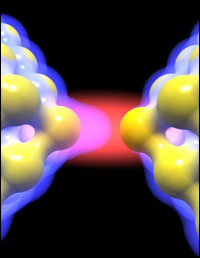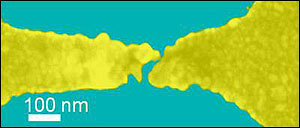
Nano Antenna Captures Light
HOUSTON, Sept. 23, 2010 — Antennas capture aerial signals that make devices, such as radios and cell phone, work better. Now, a lab at Rice University has built an antenna that captures light in the same way, at a small scale that has big potential.

Artist's rendering shows how plasmons in a pair of gold nanotips concentrate light from a laser, amplifying it by a factor of 1000. (Images: Natelson Lab/Rice University)
Condensed matter physicist Doug Natelson and graduate student Dan Ward have found a way to make an optical antenna from two gold tips separated by a nanoscale gap that gathers light from a laser. The tips "grab the light and concentrate it down into a tiny space," Natelson said, leading to a thousand-fold increase in light intensity in the gap.
Getting an accurate measurement of the effect is a first, said Natelson, who reported the results in today's online edition of the journal Nature Nanotechnology. He expects the discovery will be useful in the development of tools for optics and for chemical and biological sensing, even at the single-molecule scale, with implications for industrial safety, defense and homeland security.
The paper by Natelson, Ward and their colleagues in Germany and Spain details the team's technique, which involves shining laser light into the gap between a pair of gold tips less than a nanometer apart — about a hundred-thousandth the width of a human hair.
"You can ignore the fact that your car antenna is built out of atoms; it just works," said Natelson, a Rice professor of physics and astronomy, and also electrical and computer engineering. "But when you have tiny pieces of metal very close to each other, you have to worry about all the details. The fields are going to be big, the situation's going to be complicated and you're really constrained. We've been able to use some physics that only come into play when things are very close together to help figure out what's going on."

This is a colorized scanning electron microscope image of gold tips in a nanogap device used in experiments to capture and amplify light.
The key to measuring light amplification turned out to be measuring something else, specifically the electrical current flowing between the gold tips.
Putting the nanotips so close together allows charge to flow via quantum tunneling as the electrons are pushed from one side to the other. The researchers could get electrons moving by pushing them at low frequencies with a voltage, in a highly controllable, measurable way. They could also get them flowing by shining the laser, which pushes the charge at the very high frequency of the light. Being able to compare the two processes set a standard by which the light amplification could be determined, Natelson said. Their German and Spanish coauthors helped supply the necessary theoretical justification for the analysis.
The amplification is a plasmonic effect, Natelson said. Plasmons, which may be excited by light, are oscillating electrons in metallic structures that act like ripples in a pool. "You've got a metal structure, you shine light on it, the light makes the electrons in this metal structure slosh around," he said. "You can think of the electrons in the metal as an incompressible fluid, like water in a bathtub. And when you get them sloshing back and forth, you get electric fields.
"At the surfaces of the metal, these fields can be very big — much bigger than those from the original radiation," he said. "What was hard to measure was just how big. We didn't know how much the two sides were sloshing up and down — and that's exactly the thing we care about."
By simultaneously measuring the low-frequency electrically driven and the high-frequency optically driven currents between the tips, "we can figure out the voltage zinging back and forth at the really high frequencies that are characteristic of light," he said.
Natelson said his lab's homebuilt apparatus, which combines nanoscale electronics and optics, is fairly unusual. "There are a lot of people who do optics. There are a lot who do nanoscale electrical measurements," he said. "There are still not too many people who combine the two."
The custom rig gave the Rice researchers a measure of control over thermal and electrical properties that have stymied other investigators. The tips are cooled to 80 Kelvin, about -315 ºF, and are electrically insulated from their silicon bases, keeping at bay stray voltages that could skew the results.
"The reason we're studying these enhanced fields is not just because they're there," Natelson said. "If you can enhance the local field by a factor of 1000, there are lots of things you can do in terms of sensors and nonlinear optics. Anything that gives you a handle on what's happening at these tiny scales is very useful.
"This is one of those rare, happy cases where you are able to actually get information — very local information — about exactly something you care about."
The paper's co-authors are Falco Hüser and Fabian Pauly of the Karlsruhe Institute of Technology, Germany; and Juan Carlos Cuevas at the Autonomous University of Madrid, Spain.
Support for the project came from the Robert A. Welch Foundation, the Lockheed Martin Advanced Nanotechnology Center of Excellence at Rice, Deutsche Forschungsgemeinschaft, the Baden-Württemberg Siftung, the European Union through the Bio-Inspired Approaches for Molecular Electronics network and the Spanish Ministry of Science and Innovation.
For more information, visit: www.rice.edu
Published: September 2010